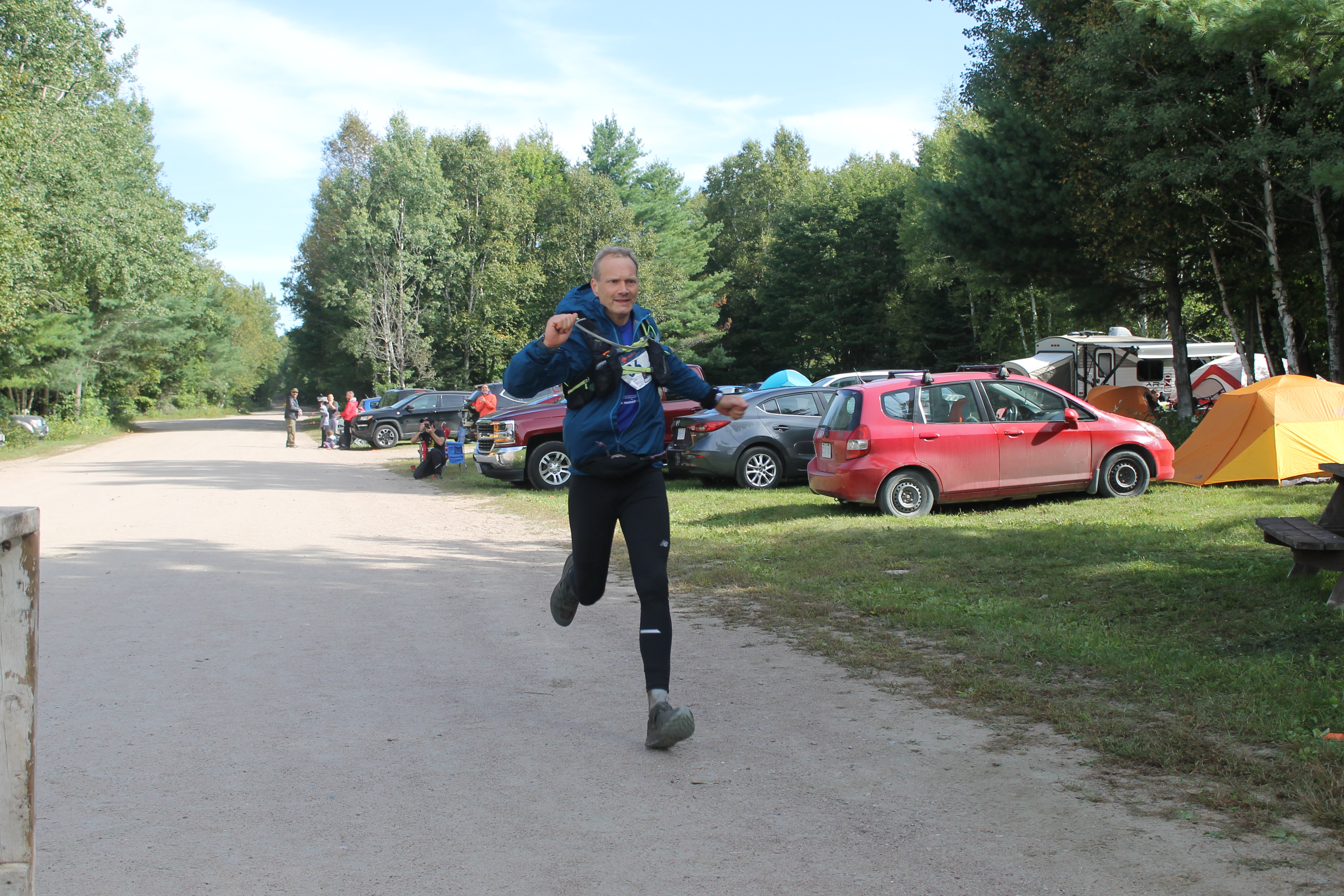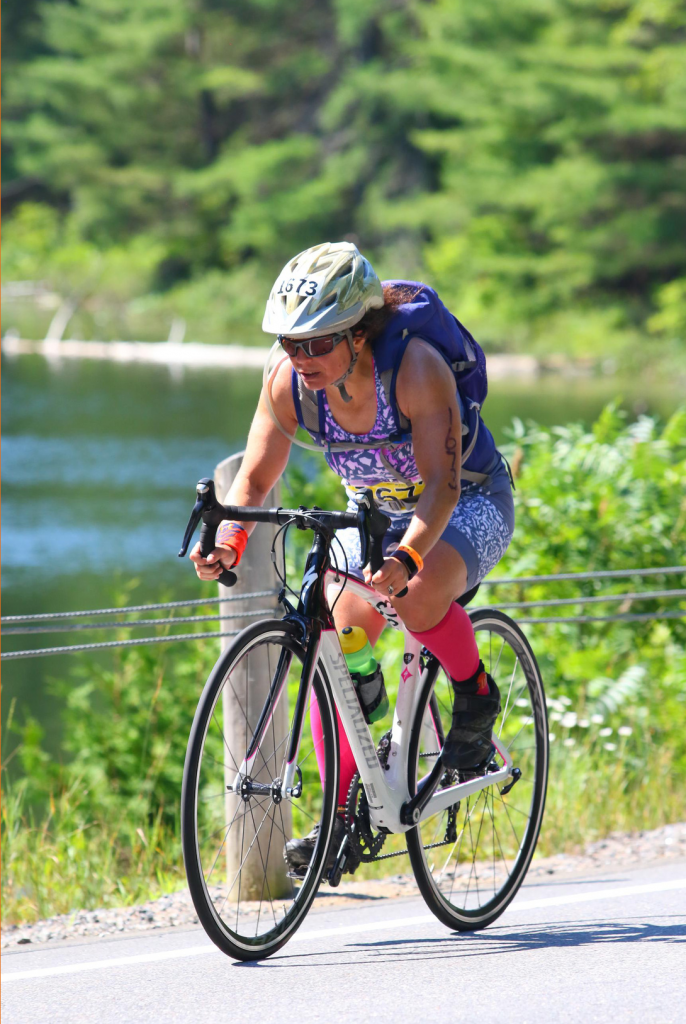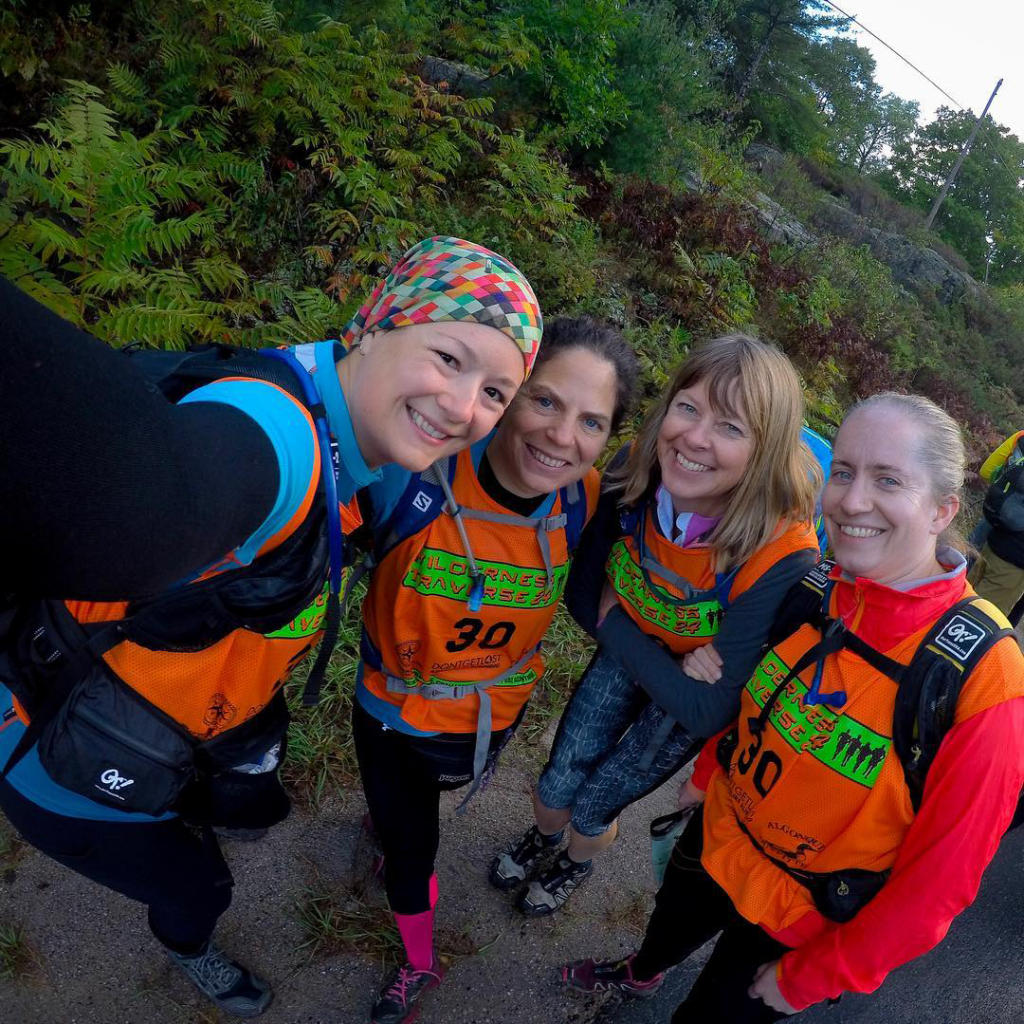I ran 100 miles in 28 hours and 36 minutes, in the Haliburton Forest Trail Race on September 8-9 2018. This gave me a nice feeling of accomplishment, and I will reflect here about my experience, and the training leading up to it.
An ultramarathon is a foot race that is longer than a marathon (26.2 miles). In 2016, I ran my first ultramarathon in 5h45m. This was the 50 kilometer version of the Haliburton Forest race. In 2017, I ran the 50 mile version in 10h56m. That year, Ilana also ran the 50K, and came in 6th out of 18 female runners.
In 2018, I ran the 100M race. This was qualitatively different than 2×50 miles, (or 3.8 marathons), not just quantitatively different. Differences included:
- It continues overnight, from 6am until the end
- It requires more logistics for gear, such as changes in clothing
- Temperature changes, especially overnight, would impact gear choices, running pace, and hydration
- It requires greater emphasis on nutrition and hydration
- Things that don’t wear out or break during shorter races might not last 100 miles. This includes batteries, band-aids and anti-chafing gel, socks, and other gear
The race had a required briefing and dinner for all 100M runners the night before. Ilana graciously agreed to drop me off, and pick me up after the race – so that I didn’t need to drive, and also so she could potentially come out and run with me for the last 7-mile loop. I brought camping gear to stay overnight among many runners and volunteers who camped prior to the 6am start.
I picked up my bib, number 36, and deposited my drop bags for their delivery to the aid stations.
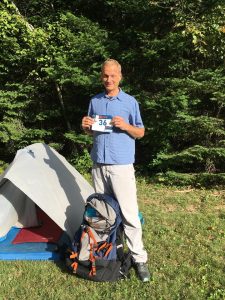
During the dinner, I chatted with someone from Toronto who had run the 100M Haliburton race 8 times previously, and had also run many other ultramarathons. He had one main piece of advice: keep moving. He also reinforced my intention to keep hydrated, and keep eating.
“Keep moving” was the same advice I heard from many other experienced runners. It didn’t matter how fast: walking, running, or anything in-between. But keep moving. When you stop, your muscles might cramp up, pain might set in, and so will the cold. Just as importantly, motivation may wane.
I slept reasonably well, and was up at 5am getting ready for the 5:45 convocation and 6am start. Final preparation included topping off the batteries in my Garmin watch and my phone, a light breakfast and a few cups of coffee, and some stretching. It was 1/2 hour before sunrise, with a temperature of around 40F. Time to run!
The Race
The 50K, 50M and 100M races all started at the same time. The race course is an out-and-back, which is done twice for the 100-mile race. From the starting line at the camp’s base, it’s around 3.6 miles on a gravel road to a 3.7-mile hilly loop around a lake (Nordac Trail). From there, the course follows a series of very hilly trails for 7.2 miles. Very, very hilly, as in there are sections with switchbacks and steep steps up rocks and roots. After that, slightly more than halfway to the turnaround, the trail tends to be less steep (though seldom flat), and includes gravel and dirt roads as as well as double-tracked trails. The turnaround is 1/2-mile beyond the last aid station (#7), at the 25-mile mark (40.2km).
The 50K turnaround is a little past aid station 5 at mile 14.5, which is where the very hilly trails end and the less hilly sections begin. It’s a very friendly race, with lots of passing on the trail and at turnarounds. There was lots of light chit-chat about “what race are you doing,” and “have you been here before?,” and some socializing at the aid stations. Aid station staff were incredibly friendly, upbeat and helpful, and really cared about keeping everyone running, well-fed, and hydrated.
According to official race results, there were 33 runners who started the 100M race, and 28 finished within the 30-hour cutoff. There were approximately 56 people in the 50M race, and 62 in the 50K. There were also shorter races with a later start time (and more people). While 50K runners would have encounters on the trail with those racers, the 50M and 100M runners never even saw them: the shorter races began and finished while we were out on the course.
I timed my first marathon at around 5 hours (not including a few minutes spent at aid stations), and my second marathon at 6.5 hours. My tracking systems didn’t give me an accurate time for the third marathon, but it was in the vicinity of 8.5 hours. I completed the first lap (50M) in 11h10m, compared to 10h56m last year. Walking up hills and taking a slightly slower pace at the beginning led to a slightly longer 50M time.
My time ranked me 24th overall out of 28 finishers, and 6th out of 8 “male 50+” runners. I’m very happy with this outcome.
During the race, I had been guided to not burn out by pushing too hard, and also to consider walking up steep hills. Instead of my usual 8 or 8.5-minute miles at the start, I ran a more leisurely 9-9.5-minute miles. And, I walked up the steeper hills on the first 25M, even though I wasn’t tired. Walking up the hills, or simply not trying to push hard up the incredibly steep hills (Ben’s Trail, Krista Trail, and Vista Trail especially), is a great way to give the body a little rest.
For the first 25M, I ran almost continuously. There is no way to keep a steady pace, since the terrain changes so much – this includes steep downhills, where it’s perilous, at best, to try to move too quickly over narrow, twisty trails with loose rock, dirt, and foliage. During the second 25M on the way back, I was running more slowly, and keeping up a brisk walking pace while going uphill. I managed to miss a turn, and ran an extra 1/2 mile. I wasn’t lost, I was simply in the wrong place.
By the third 50M (the start of the 2nd lap) I was running and walking more slowly, but was still able to run some miles under 10 minutes. Things got dark, cold and lonely during this section. After 50M, there were only a few dozen racers on the trail, though many picked up pacers after 8pm Saturday night. By then, the racers were quite spread out, and in fact the winner passed me while he was incoming on his last segment, and I was around mile 15 on the third segment: he was over 30 miles ahead of me!
During the overnight, I went for hours without any head-on passes, and was only passed by two racers between 8pm Saturday and 10:00am Sunday. I didn’t pass anyone. I did have plenty of head-on passes, though, especially in the miles leading in and out of the turnaround at aid station #7. The loneliness didn’t bother me at all. My spirits were high, and I was enjoying the run and the trail. I spotted two porcupines, one of whom was running along the trail ahead of me for a short distance.
My lonely existence was punctuated by the aid stations. #s 4, 5, 6 and 7 are on the long out-and-back, and each featured a campfire, hot drinks, and snacks. Station volunteers were friendly and upbeat, and I think some of them were feeling a little lonely, too, during the long cold overnight.
By the time I was heading out of #7 on my final 25-mile segment back to base camp, I was running much more slowly. I was still doing a few miles under 14 minutes, but trending ever more slowly with some miles closer to 20 minutes (i.e., 3 miles per hour, versus better than 6 miles per hour at the start of the race). Going out of aid station #5 (i.e., after around 85 miles), I was having some pain in my quadriceps and feet, especially when going downhill.
What I think happened was, I was not adequately trained for hills (maybe downhills, or maybe both up and down). I have some very hilly training routes (more on that below), but by the time I was on the last series of steep trails I was having pain from the jolt of stepping downhill, and couldn’t even keep a rapid pace on the slight downhill of a gravel road. I wasn’t getting much length to my stride. During the last 12 miles or so, I was mostly trotting/walking, or sometimes just walking, at 2-3 m.p.h. This is slower than a normal brisk walk of around 4 m.p.h. (i.e., 15-minute miles), which was the pace I was walking up hills earlier in the race.
This pain and slowness didn’t discourage me. I knew I was going to keep going. I was doing the math, and I knew that I was still on track to finish by the 30-hour cutoff. I had already easily beaten the earlier cutoff, which was to reach the 75-mile turnaround by 4am. I was there by around 1:30am, and despite the increasing pain in my quads and feet I remained in good spirits, and never felt like I had made a mistake by deciding to try a 100-mile foot race.
The sun came up a little after 6:30am on Sunday, while I was on Poacher’s Trail. Poacher’s is less dramatically hilly than Ben’s, Krista and Vista, though it still has some switchbacks and steep sections. I was trotting/walking, mostly around 3 m.p.h. (18-21 minute miles). A mile before aid station 2 and the Normac Loop, I spoke with Ilana on the phone to make arrangements for her to meet me. She had left home around 7am (wow! thanks!) to come out to meet me.
Ilana met me on the trail coming out of aid station #3, and was alongside me for the last 3.5 miles or so. By then, I was no longer trying to trot/run much, and was mostly walking at around 3 m.p.h. It was fine, though. I mustered enough energy to sprint the last 15 seconds to the finish line, and ended the race with a smile on my face and a feeling of accomplishment.
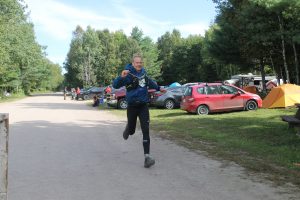
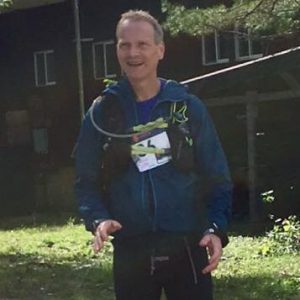
Hydration and Nutrition
I wear a Nathan brand hydration pack, which is a little backpack with a 2-liter water bladder and hose for sipping. Also a few pockets, and some storage area in the back. This is remarkably comfortable. During hot training runs, I would drink 2 liters in around 10 miles (i.e., 90-100 minutes). In Haliburton, I augmented the water in the hydration pack with drinking Gatorade at the aid stations. For the first few stations, I would have several cups. But starting at aid station 5 (i.e., mile 14.5) and for the rest of the race, I would take around 2/3 of a liter in a Platypus drinking bladder.
The Platypus was a great idea. The sippy straw in the Nathan does not give a high flow. But with the Platypus, I would drink the whole thing within 10-15 minutes of leaving the aid station. I think this was effective in keeping me hydrated, and also the Gatorade helps with electrolyte replacements (especially salt). It was not very hot during this race, but it is still a lot of exertion, and fluid replacement is important.
Saturday night it began to get cold, and I started asking the aid stations for hot water instead of Gatorade (I still had a few cups of Gatorade while at the aid stations). This worked well. The thrill came at #7 when I was getting to the turnaround for the final 25 miles. They had a French press to make coffee! They brewed it while I went to the turnaround, and I enjoyed a half liter of caffeinated warmth.
For food, I mostly was eating what I brought. I was aiming for a few hundred calories per hour, and had a bunch of Gu-brand gels, Clif gel blocs (yes, with caffeine) and a few other things. I had some veggie dogs that I munched on, and they went down very easily. The food I took at the aid stations was peanut butter & jelly sandwiches (on white bread, quartered) and boiled potatoes.
At #7, like all the checkpoints, I was offered a variety of foods. For the first stop there, I ate a bunch of watermelon. For the second stop (15 hours later, when I got coffee) I spotted an apple pie. That was a treat!
The apple pie might not have been completely vegan, but I wasn’t going to try to parse the ingredients list. Otherwise, I maintained my regular vegan diet, throughout the race. No problemo.
Checkpoint #5 also had pie. Rhubarb, this time. This was just what I needed, in the middle of a cold night. And then, finally, checkpoint #3, just before the last few miles to the end, had blueberry pie. I had bypassed the chips, nut mix, gummy worms, and other junk food at the checkpoints, but really enjoyed the pie.
Pie.
Gear
I mentioned my Nathan hydration pack, above. My main running gear was typical: a headband, running shirt (short sleeve during the day, then switching to long sleeve at night), compression shorts. I wear relatively heavy full-length socks, which helps with padding, and also the full length keeps some of the brambles from scratching me.
My shoes are a new discovery, Saucony Ultra Pro (size 13) trail running shoes. Unlike most running shoes, these have a toe box that doesn’t cramp my toes. My second toe is a little longer than my big toe, and even though my foot is definitely “medium” width (i.e., 13-D), my toes get rubbed by many other shoe brands. The Sauconys are rather firm, which might have led to my foot soreness described above, but they are also very sure-footed with great soles. These are the best-fitting shoes I have had for long trail runs, but I wish they were more cushioned.
I carry my Android phone so that I can use Strava to track my runs. This usually works really well: Strava doesn’t need a cell phone signal to work, at least at home. I subscribe to the “beacon” function, that lets others know where I am in nearly real time. I also use my phone for music, by putting it in the Nathan pocket and playing over the speaker. Since I am mostly running alone, this doesn’t bother anyone, and I can hear the surrounding area better by not wearing earphones.
During the 100-miler, I never listened to music. I had a big playlist planned, but decided to just enjoy the silence. Also, I wanted to hear anyone or anything nearby, especially on those dark lonely trails at night.
Strava turned out to be a problem. I started it, and then discovered hours later it wasn’t tracking properly. I never figured out why. I tried restarting (and restarting the phone), using with and without beacon mode, etc. I had some little battery chargers to charge it up after being in beacon mode, but they were barely necessary since tracking wasn’t happening. There wasn’t much phone signal in the forest, but around the last turnaround after #7 I had a signal so restarted everything. Then, Strava wanted me to login again (huh?). It just never worked. After the race on Sunday, I tried again and it forced an upgrade, made me login, and made me accept terms and conditions twice. Major fail by Strava. Last year, on the same course, it worked fine.
What did work well was my Garmin watch. This is a fantastic gizmo Ilana bought me early in the year. It syncs with the phone, and tracks heartbeat, pace, and of course time and distance. That is how I knew my pace, throughout the race. The only problem was it turned off suddenly in the middle of the night, without giving me any warning it was running out of power. I charged it with my battery pack, and carried on.
For the overnight, I had two headlamps. One was a 300 lumen headlamp, with 3 AAA batteries. It lasted around 3 hours. The other was a much brighter headlamp, a Lupine brand monster with 800 lumens and big batteries. This also lasted around 3 hours before needing a battery swap. I used the Lupine on the hillier sections, and the other on the flatter sections. These headlamps gave good contrast, and I was able to keep very good footing overnight – maybe even better than during the day (though I was also moving more slowly).
The only downside of night running is the tendency to need to look down, constantly. This eventually gave me a sore neck.
Cold
Saturday morning, it was perhaps 40F. I wore light gloves and a light buff cap. After a few miles, I put those away, and stayed warm and comfortable all day.
By the time the sun was going down (7:44pm) I was back at aid station #2, where I had a drop bag with a full change of clothing. I put on a long-sleeve shirt, and swapped a few other items. I didn’t put on my runner’s tights, though, because it was still fairly warm (around 60F). I had left a nice fleece running top at the aid station, and decided not to take it. The forecast had been for lows in the mid-40s. I kept thinking about it, and almost went back for it. It would have been a bulky item to fit in my pack, especially if I didn’t need it.
By the time I got to aid station #5 and my second drop bag, I was getting cold. I had a rain jacket there, and put it on. That helped a lot. And then, at #6 (just a few miles later), I put on the tights. Overall, I was almost warm enough, throughout the night. Temps got down to around 35F – colder than forecast. But not windy at all. I should have taken my fleece, but managed ok without it. If I was running faster, I would have kept warmer.
Injuries
No injuries. I tripped and stumbled a few times in the woods, but only fell once and didn’t hurt myself. There are miles of very rough trails, with loose rocks, brambles, and other hazards. Did I mention the hills are steep?
After the race, I had some tightness in my legs. Also I discovered a few areas with rub spots, and a blister on a toe. My main pain during the race was what I descried above with going downhills.
Mindset
I had heard and read, over and over, that the 100M race involves pain. I did have some pain, but mainly for the last 15 miles, and it was more due to over-use than an acute injury. So, I expected pain, and planned to soldier through it. But it was not as bad as I feared.
The race started out very social, running alongside 50K and 50M runners and through aid stations that were just getting started for the day. This was great, because I had plenty of energy to be social, and was curious to meet my fellow runners. By the time I was heading out on the 2nd 50 mile loop, though, there was a lot less interaction, other than at checkpoints. This also suited me well, since I needed to concentrate more on my footing, and was not as alert.
Mostly I had a quiet mind, and was paying attention to where I was and what I was doing. I was surprised that I wasn’t bored by the run, and wasn’t bothered by long sections with no interaction. It was peaceful.
Afterwards
Mostly I only had muscle fatigue and a few areas where my clothing had rubbed my skin. I didn’t have dehydration. I was hungry, though, and had a big lunch during the Sunday awards ceremony. After a nap at home that afternoon, I had two dinners!
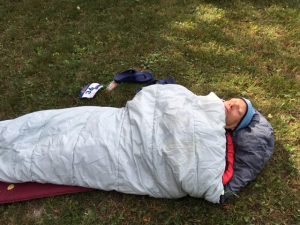
Training
Strava tells me I ran just over 2000 miles this year, before the race. I also spent time on the treadmill and elliptical machines. Our house is on a fantastic trail system, and there are also plenty of dirt roads. My main goals were to get lots of time and distance. In the future I might try to emphasize a little more speed, and also some sort of focus on getting more hills.
Maybe I’ll do this Again?
The race was very challenging. It was fun. I learned a few things that would improve my experience, if I try it again. There are lots of other ultra races in Ontario, and elsewhere, and perhaps I will try some of those, too.
Special thanks to Ilana for supporting me during all the training, and during the race!
